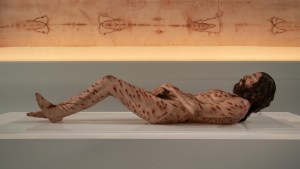Few objects have been at the heart of as much debate as the Shroud of Turin. As early as the 14th century, it was the subject of controversy between its Champagne owners and the Bishop of Troyes. In the 16th century, when its veneration as a relic of the Passion was instituted in Chambéry, it was the object of Calvin’s wrath. He mocked the dozen or so shrines claiming to possess Christ’s funerary linen, before it was defended by a wealth of Catholic scholarship.
Its renewed fame in 1898, thanks to a photographic negative revealing the imprint of Christ’s face, sparked new discussions about how the image could have been formed. The Shroud’s carbon-14 dating results in 1988, which suggested it originated in the Middle Ages, didn’t put an end to the debate.
The permanence of this object in history has few rivals. The same applies to the extent of the literature devoted to it over the centuries, sometimes based on polemics against relics, sometimes on apologetics defending them, and sometimes on the physical sciences or forensic medicine.
Fruitful investigations
Whether we regret it or welcome it, historians sometimes work against the grain on the most high-profile issues. The Shroud was long shunned by academic history, and since the 1980s and 90s it has been absent from summaries of the history of Christianity and numerous works devoted to relics.
In fact, it was by ignoring the question of objects of worship that researchers highlighted their importance in Christian societies. With the Shroud, they risked being brought back to this fateful question.
It was not until the 2010s that new research began. It has taken place notably at the University of Turin with Paolo Cozzo, Laura Gaffuri, and Andrea Nicolotti, but also in the USA with Andrew Casper, and in France with Pierre-Olivier Dittmar. These investigations proved highly fruitful: Regarding this object, sometimes presented as the most studied in the world, dozens of sources were discovered that nobody had looked at until then.
The Chambéry fire
To cite just a few, there are the municipal deliberations of the town of Chambéry, where the Shroud was venerated in the 16th century before being transported to Turin. They contain a multitude of measures taken to accommodate the crowds of worshippers who came to see the relic, such as repairing bridges, guarding gates, regulating prices, policing to prevent petty theft and crowd movements.
In 2011, a draft of a speech to the Duke was rediscovered on a loose leaf in the Savoy Archives. While a plague epidemic had prompted the Duke to suspend the annual viewing of the Shroud, the municipality urged him to maintain the rituals, citing the influx of worshippers, the growing power of Lutheranism in the region, and the relic’s expected miraculous efficacy.
The great devotion paid to this famous shroud is far from an isolated case.
We should mention the fire at the Sainte-Chapelle in Chambéry in December 1532, during which the Shroud was partially burnt, necessitating repairs by the town’s Poor Clares. The ducal accounts record the purchase of the cloth used to line the Shroud, as well as other expenses to equip it with a new reliquary, precious fabrics, and a rod around which to wrap it. Andrea Nicolotti has also unearthed the touching mention of a homespun cloth offered to a Franciscan from Chambéry in gratitude for the help given to the Dukes during this nocturnal rescue, which no other contemporary source describes.
A multiplicity of Shrouds
The great devotion paid to this famous shroud is far from an isolated case. In a Christendom overflowing with relics, Cadouin, Compiègne, Kornelimünster, the Lateran in Rome, and many other shrines — in all, more than 130 — claimed to venerate a cloth or a piece of cloth that had wrapped Christ in the tomb.
Added to this were the numerous copies of the Shroud of Turin. Some were shown to the faithful so that they could show their devotion, from a distance, to the Savoyard prototype. Others were venerated as authentic relics, like the Shroud of Besançon, which enjoyed prominent veneration until its destruction during the Revolution.
Although this multiplicity may trouble contemporary observers, St. Francis de Sales, for example, recounted without embarrassment in his correspondence that he had seen the Shrouds of Turin and Besançon. Louis Richeome wrote in 1600, “We shouldn’t be flabbergasted; it could be that several [of these images] were drawn together, or that he who drew the first ones miraculously, multiplied them miraculously.” The nuns of the convent of Xabregas, near Lisbon, recount how the Shroud of Turin duplicated itself all on its own. The duplicate, they claimed, could not be distinguished from the original: the relic — and this is not the least of its powers — is endowed with ubiquity.
The need for more historical research
Philosopher Bruno Latour and artist Adam Lowe note that, while many adventurers have sought out the sources of the Nile, the river’s wealth lies precisely in the extent of the watershed that they leave behind. A similar inversion of perspective has led to an increasing number of discoveries about the Shroud, and new sources are bound to emerge in the years to come. They document how generations of devotees have looked at the same object, at every stage of its long history.
For more info


